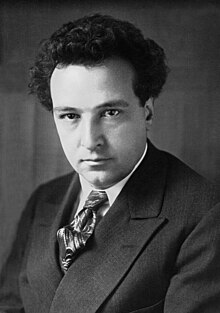| Symphony No. 5 | |
|---|---|
| Di tre re | |
| by Arthur Honegger | |
 The composer in 1928 | |
| Composed | 1950 |
| Dedication | Natalie Koussevitzky Foundation |
| Performed | 9 March 1951: Boston |
| Movements | three |
The Symphony No. 5 by Swiss composer Arthur Honegger is a three-movement work for orchestra written in the autumn of 1950. Its subtitle Di tre re (of the three Ds) is a reference to the D (re) played by the solo timpani and basses at the end of each movement. It was commissioned by the Natalie Koussevitzky Foundation and first performed on 9 March 1951 by the Boston Symphony Orchestra under Charles Munch. [1]
Honegger's Fifth Symphony is a three-movement work with a total running time of about 22 minutes. Its three movements are marked:
- Grave (approx. 7'20")
- Allegretto - Adagio - Allegretto - Adagio - Allegretto (approx. 9'00")
- Allegro marcato (approx. 5'30")
This symphony is published by Éditions Salabert.